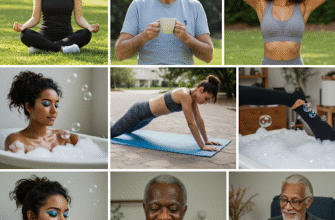In the hustle and bustle of modern life, we often find ourselves caught up in the whirlwind of to-do lists, future anxieties, and past regrets. Our minds race from one task to the next, rarely pausing to fully appreciate the present moment. This constant state of distraction can lead to feelings of stress, disconnection, and a general sense of unease. But what if there was a way to break free from this cycle and cultivate a greater sense of peace and well-being? The answer, it turns out, lies in the daily practice of being present.
Understanding Presence
Presence, at its core, is the state of being fully engaged with the here and now. It’s about paying attention to our thoughts, feelings, and sensations without judgment, allowing ourselves to experience life as it unfolds in each moment. It’s about acknowledging the present reality without getting swept away by worries about the future or dwelling on the past. In essence, presence is a conscious choice to embrace the current experience, whatever it may be.
The Benefits of Practicing Presence
The benefits of cultivating presence are numerous and far-reaching. Studies have shown that mindfulness practices, which are closely related to presence, can reduce stress, improve focus, enhance emotional regulation, and increase overall well-being. By consciously bringing our attention to the present moment, we can:
- Reduce Stress and Anxiety: When we’re present, we’re less likely to get caught up in worries about the future or regrets about the past, which are major contributors to stress and anxiety.
- Improve Focus and Concentration: By training our minds to stay in the present moment, we can improve our ability to focus and concentrate on the task at hand.
- Enhance Emotional Regulation: Presence allows us to observe our emotions without judgment, giving us the space to respond to them in a more skillful and adaptive way.
- Increase Self-Awareness: By paying attention to our thoughts, feelings, and sensations, we gain a deeper understanding of ourselves and our patterns of behavior.
- Cultivate Gratitude and Appreciation: When we’re present, we’re more likely to notice and appreciate the small joys and blessings in our lives.
- Improve Relationships: Being present in our interactions with others allows us to listen more attentively, respond more thoughtfully, and connect on a deeper level.
Research consistently demonstrates the positive impact of mindfulness on mental health. Mindfulness practices have been shown to reduce symptoms of anxiety, depression, and stress, while also improving overall well-being and quality of life.
Practical Techniques for Cultivating Presence
The good news is that presence is a skill that can be developed and strengthened through regular practice. Here are some practical techniques you can incorporate into your daily life to cultivate a greater sense of presence:
Mindful Breathing
Mindful breathing is one of the simplest and most effective ways to cultivate presence. It involves paying attention to the sensation of your breath as it enters and leaves your body. You can do this anytime, anywhere, for just a few minutes at a time. Here’s how:
- Find a comfortable position, either sitting or lying down.
- Close your eyes gently or lower your gaze.
- Bring your attention to your breath. Notice the sensation of the air as it enters your nostrils, travels down your throat, and fills your lungs.
- As you exhale, notice the sensation of the air leaving your body.
- If your mind wanders, gently redirect your attention back to your breath.
Mindful Walking
Mindful walking is another great way to cultivate presence while getting some exercise. It involves paying attention to the sensations of your body as you walk, such as the feeling of your feet on the ground, the movement of your arms, and the air on your skin. Here’s how:
- Find a quiet place to walk where you won’t be disturbed.
- Start walking at a comfortable pace.
- Bring your attention to the sensations of your body as you walk. Notice the feeling of your feet on the ground, the movement of your legs, and the air on your skin.
- If your mind wanders, gently redirect your attention back to the sensations of your body.
Mindful Eating
Mindful eating involves paying attention to the taste, texture, and smell of your food as you eat. It’s about savoring each bite and appreciating the experience of nourishment. Here’s how:
- Find a quiet place to eat where you won’t be distracted.
- Take a few deep breaths before you start eating.
- Look at your food and appreciate its colors and textures.
- Take a small bite and savor the taste. Notice the different flavors and sensations in your mouth.
- Chew your food thoroughly and swallow slowly.
- Pay attention to how your body feels as you eat.
- If your mind wanders, gently redirect your attention back to your food.
Body Scan Meditation
A body scan meditation involves systematically bringing your attention to different parts of your body, noticing any sensations that are present. This practice can help you become more aware of your body and your physical sensations. Here’s how:
- Lie down on your back in a comfortable position.
- Close your eyes gently.
- Bring your attention to your toes. Notice any sensations that are present, such as tingling, warmth, or pressure.
- Gradually move your attention up your body, focusing on each part in turn: your feet, ankles, calves, knees, thighs, hips, abdomen, chest, fingers, hands, wrists, forearms, elbows, upper arms, shoulders, neck, face, and head.
- As you focus on each part of your body, simply notice any sensations that are present without judgment.
- If your mind wanders, gently redirect your attention back to your body.
Labeling Thoughts and Emotions
This technique involves observing your thoughts and emotions without getting carried away by them. Instead of getting caught up in the content of your thoughts, simply label them as “thinking” or “feeling.” This can help you create some distance between yourself and your thoughts and emotions, allowing you to observe them with greater clarity.
It is important to consult with a qualified healthcare professional if you are experiencing significant mental health challenges. While mindfulness practices can be beneficial, they are not a substitute for professional medical or psychological care.
Practicing self-compassion is key. Be kind and patient with yourself as you learn to cultivate presence.
Integrating Presence into Daily Life
The key to cultivating presence is to integrate it into your daily life. Here are some simple ways to do this:
- Start your day with a few minutes of mindful breathing or meditation. This can help you set a positive tone for the day and cultivate a greater sense of calm and focus.
- Take short breaks throughout the day to check in with yourself. Notice your thoughts, feelings, and sensations without judgment.
- Practice mindful listening in your conversations with others. Pay attention to what the other person is saying without interrupting or formulating your response.
- Be present in your daily tasks, even the mundane ones. When you’re washing dishes, for example, pay attention to the sensation of the water on your hands and the smell of the soap.
- Cultivate gratitude for the small things in life. Take a moment each day to appreciate the simple joys and blessings in your life.
- Limit distractions. Reduce your exposure to social media, news, and other sources of information that can pull you away from the present moment.
Overcoming Challenges
Cultivating presence is not always easy. It requires patience, persistence, and a willingness to be with discomfort. Here are some common challenges you may encounter and how to overcome them:
- Mind Wandering: It’s natural for your mind to wander. When it does, gently redirect your attention back to the present moment without judgment.
- Restlessness: You may feel restless or fidgety when you try to sit still and be present. This is normal. Try to observe your restlessness without resisting it.
- Negative Thoughts and Emotions: You may experience negative thoughts and emotions when you’re trying to be present. This is also normal. Acknowledge your thoughts and emotions without getting carried away by them.
- Lack of Time: You may feel like you don’t have time to practice presence. Start small. Even a few minutes a day can make a difference.
The Journey to Presence
The journey to presence is a lifelong journey. There will be times when you feel more present than others. The key is to keep practicing and to be kind to yourself along the way. With patience and persistence, you can cultivate a greater sense of peace, joy, and fulfillment in your life.
The daily practice of being present is not a quick fix, but a continuous process of self-discovery and growth. Embrace the journey, celebrate the small victories, and remember that every moment is an opportunity to connect with the present and experience life to the fullest.








